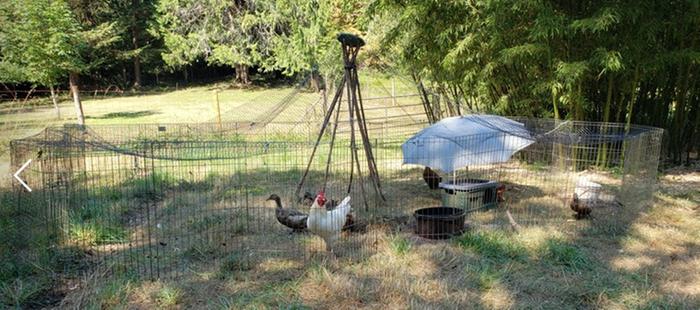




Leela
Kindred Hill Farm
Deering, NH
Kindred Hill Farm on Facebook
 2
2




 1
1




Alder Burns wrote:Two ideas come to mind, both of which I've done in different settings:
1. Pound sections of pipe into the ground where you want your poles to be. Pull them out as you pound them in to knock the soil out, so that when they are sunk in, the inside of the pipe is empty. Have these wider than your poles and simply drop the poles into them. The other way would be permanent stakes, say two or three feet tall, that your poles (pipes? bamboo?) fit down over.
2. especially for hard or rocky ground, use tall tripods made of bamboo or other lightweight material....these would be moved with the net....
Another hint...a jar, or even a metal can, over the end of the poles allows the net to slide over them and stretch without catching on the end....
Leela
Kindred Hill Farm
Deering, NH
Kindred Hill Farm on Facebook
 1
1




Alder Burns wrote:Two ideas come to mind, both of which I've done in different settings:
1. Pound sections of pipe into the ground where you want your poles to be. Pull them out as you pound them in to knock the soil out, so that when they are sunk in, the inside of the pipe is empty. Have these wider than your poles and simply drop the poles into them. The other way would be permanent stakes, say two or three feet tall, that your poles (pipes? bamboo?) fit down over.
2. especially for hard or rocky ground, use tall tripods made of bamboo or other lightweight material....these would be moved with the net....
Another hint...a jar, or even a metal can, over the end of the poles allows the net to slide over them and stretch without catching on the end....




Alex Everette wrote:
I would vote for using bamboo poles. Not only is bamboo an incredibly sustainable resource, it's also stronger than steel and more robust than concrete, and way healthier for the environment than PVC pipes.
Leela
Kindred Hill Farm
Deering, NH
Kindred Hill Farm on Facebook

 2
2




 4
4






Visit Redhawk's soil series: https://permies.com/wiki/redhawk-soil
How permies.com works: https://permies.com/wiki/34193/permies-works-links-threads
 2
2




 2
2





|
Talk sense to a fool and he calls you foolish. -Euripides A foolish tiny ad:
The new kickstarter is now live!
https://www.kickstarter.com/projects/paulwheaton/garden-cards
|







